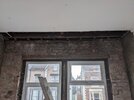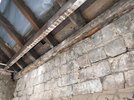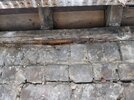Following a failed gutter for many years, both the wall plate and brickwork above the first floor front of house window are damaged. Wall plate rotten at the middle (about 500mm section), mortar all loose (see pictures). As a result, the flat area over straight bay window is slightly sunken.
Builder who came by to fix suggested cutting off the damaged wood section, replace just that section with good wood, splice the lot together and screw onto the three sections of wood (the ones now forming the wallplate) an "L" shape angle metal plate. Plus, of course, repointing the bricks under the plate.
Is this suggestion sound work? Or it is imperative (maybe even legally/standards/regulations required) that the rotten wall plate has to replaced with a WHOLE length of solid timber?
Many thanks!
Builder who came by to fix suggested cutting off the damaged wood section, replace just that section with good wood, splice the lot together and screw onto the three sections of wood (the ones now forming the wallplate) an "L" shape angle metal plate. Plus, of course, repointing the bricks under the plate.
Is this suggestion sound work? Or it is imperative (maybe even legally/standards/regulations required) that the rotten wall plate has to replaced with a WHOLE length of solid timber?
Many thanks!





